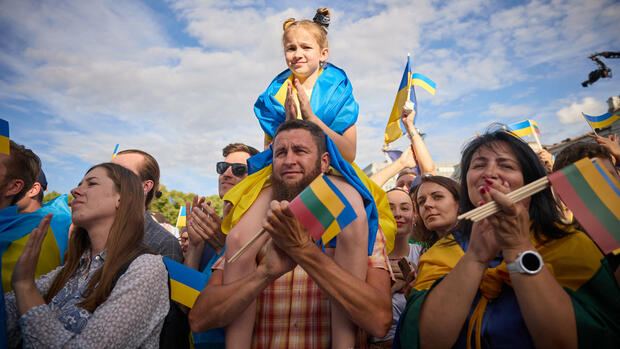Solidarity event with Ukraine during the NATO summit meeting.
(Photo: ddp/abaca press)
Vilnius The Ukrainian President had announced plain language, but when Volodymyr Zelensky arrived at the NATO summit in Vilnius on Wednesday, his anger seemed to have evaporated. Yes, there are moments when “small differences” with Western backers emerge, he said, but Ukraine is grateful for the help it is receiving in its fight against aggressor Russia.
That had sounded different the day before. On Twitter, Zelensky expressed his disappointment that the NATO countries had not invited Ukraine to join the alliance after the war. “Indecisiveness is weakness,” he raged. “For Russia, this is an incentive to continue its terror.” There was a risk of a scandal, a rift between Ukraine and its partners that would have overshadowed the NATO summit.
But on Wednesday, Selenski was much more diplomatic. The results of the Vilnius summit are to be welcomed, said Zelenski in the Lithuanian capital.
From his point of view, a formal invitation for Ukraine would have been ideal. But Selenski praised the fact that the NATO states want to refrain from demanding the otherwise usual “Membership Action Plan” for the pre-accession candidates.
This shortens the path that Ukraine has to travel in order to be accepted into the alliance at a later date. “After the war we will be a NATO member,” Zelenski said optimistically.
G7 security commitments
Until then, the Europeans and the USA want to continue to support the country. In the short term with new arms deliveries, in the medium term with extensive bilateral security arrangements. The G7 countries passed a corresponding agreement on Wednesday. Selenski called the move an “important signal” for Ukraine on the way to NATO membership.
NATO shortens the way for Ukraine to join the alliance.
(Photo: IMAGO/Belga)
Part of the statement is that the G7 countries promise Ukraine, among other things, the delivery of modern equipment for the air and naval forces. This is intended to assure Ukraine long-term military support for the defensive struggle against Russia and enable it to protect itself permanently against such aggressions.
The new commitments are not from NATO itself; like the previous arms deliveries, they are bilateral agreements between NATO members. This distinction is important because the alliance does not wish to intervene in the conflict.
>> Read also: Ukraine is paying the price for NATO’s inertia – one comment
Within the existing NATO structures, however, the NATO-Ukraine Commission will be upgraded to the NATO-Ukraine Council. The first meeting with Zelenski’s participation took place on Wednesday.
G7 aid is expected to extend beyond the end of Russia’s war against Ukraine, but Britain’s Prime Minister Rishi Sunak said there was an obligation to ensure such a war did not happen again.
Former NATO Secretary General Anders Fogh Rasmussen, who advises the Ukrainian government, described the G7 statement as an “important moment”. It shows that the Western partners are moving from “the ad hoc support provided so far to a long-term vision for Ukraine’s security”. The Kremlin called the pledges “potentially very dangerous”.
Long term support
The security concept is compared to the guarantees that Israel receives from the United States, since the Israelis have not signed a formal defense pact with the United States either. It covers four core areas: further transfer of Western weapons systems, increased exchange of intelligence, a significant expansion of training and exercises with Ukrainian armed forces, and support in building up Ukraine’s military and industrial base. In return, the country should push ahead with reforms in various areas.
“The goal is clear,” Rasmussen emphasized: “We want to make sure that Ukraine wins this war and that Russia is never in a position to do something like this again.” However, Rasmussen also warned: “Since 2008, Ukraine has been in the NATO waiting room. This is a dangerous place.”
You can find more about this topic here:
The Dane is alluding to NATO’s decision at the time to promise Ukraine accession without agreeing on concrete steps to get there. According to many experts, the lack of clarity about the NATO perspective contributed to the Russian aggression, which began in 2014 with the annexation of the Crimean peninsula and last year ended in an attempt to conquer the capital Kiev with a major invasion.
The Russians have not achieved their war aims, but they still control large areas in the east and south of Ukraine. Ukrainians have been trying to break through Russian defenses to retake their country for weeks, but progress is slow. The West is primarily supporting the Ukrainian land forces with arms deliveries. So far, Ukraine has not received any fighter jets or warships.
Selenski also met Chancellor Olaf Scholz (SPD) at the NATO summit. An agreement was reached on further Patriot anti-aircraft missiles, he said. “This is very important in order to protect lives in Ukraine from Russian terror.” The “long-term defense cooperation” was also a topic, according to Zelenski.
This form of support is “the best signal to the world that our Europe remains a place of security and peace”.
More: Germany apparently scraps deal for tank workshop in Poland
